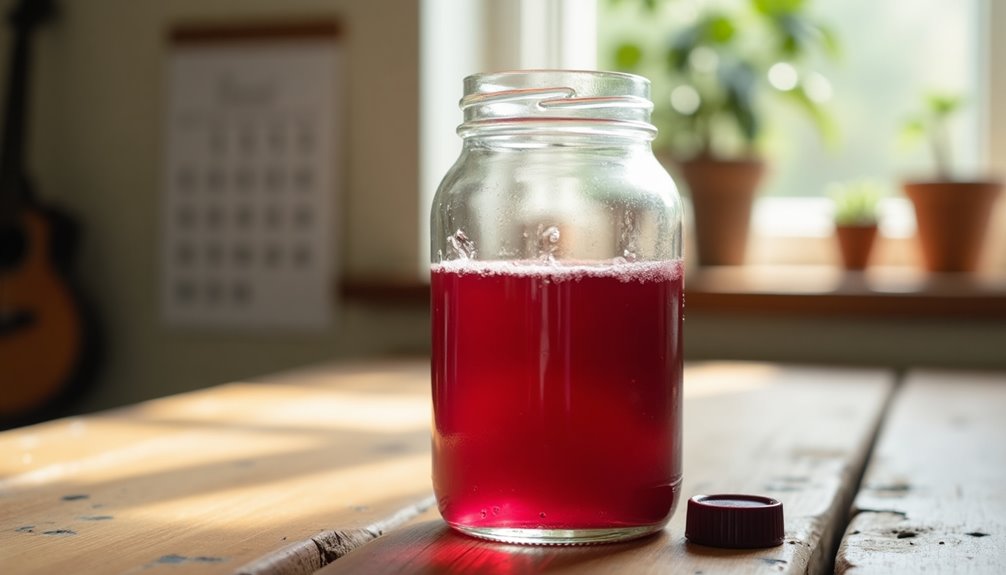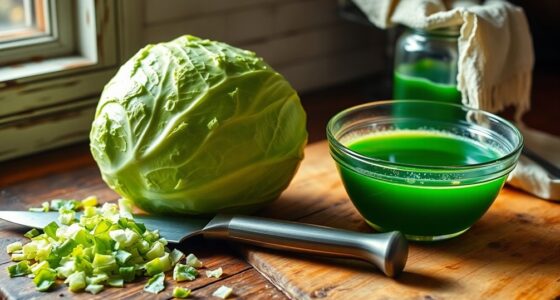Opened cranberry juice lasts about 2-3 weeks in the fridge. To keep it fresh, store it in a tightly sealed, airtight container right after pouring. Make sure to avoid leaving the juice out at room temperature, and keep it in the main compartment of the refrigerator rather than the door. Temperature changes can reduce its lifespan. Keep an eye out for any spoilage signs, and you'll find more tips to maximize your juice's freshness ahead.
Key Takeaways
- Opened cranberry juice lasts approximately 2-3 weeks when stored in the refrigerator.
- Always store juice in a tightly sealed, airtight container to maximize its lifespan.
- Avoid leaving juice out at room temperature to prevent spoilage.
- Keep the juice in the main compartment of the fridge for consistent temperature.
- Monitor for spoilage signs like changes in odor, taste, or discoloration.

Have you ever wondered how long cranberry juice lasts in the fridge? It's a great question, especially if you enjoy the tart flavor of this popular juice drink. Once you open a bottle, you need to consider how to store it properly to maximize its shelf life.
Opened cranberry juice can last approximately 2-3 weeks in the refrigerator if you keep it stored properly. The key here is to ensure that the juice is in a tightly sealed, airtight container. This keeps out air and contaminants that could shorten its lifespan. If you’re ever unsure about how long does cranberry juice last, it’s best to check for any signs of spoilage, such as an off smell or changes in color. Additionally, freezing cranberry juice can extend its shelf life significantly, allowing you to enjoy it long after the initial opening. Always remember to label the container with the date to keep track of its freshness.
When you store your opened cranberry juice in the fridge, you'll want to maintain a consistent temperature. If you leave it out at room temperature or frequently take it in and out of the fridge, the juice will last much shorter. So, always put it back in the fridge immediately after pouring a glass.
If you've thawed cranberry juice from the freezer, it's best to consume it within an additional 3-5 days after thawing, as long as you keep it refrigerated.
Now, how can you tell if cranberry juice has gone bad? There are a few signs of spoilage to watch out for. If you notice changes in the odor, flavor, or appearance of the juice, it's a good idea to toss it out.
Discoloration or mold on the surface are clear indicators that you shouldn't drink it. If it smells off or tastes sour, those are also significant signs that the juice has spoiled. Keeping an eye out for these signs will help you avoid any unpleasant surprises when you reach for that refreshing glass.
As for unopened cranberry juice, it has a much longer shelf life. When stored in a cool, dark place, unopened cranberry juice can remain shelf-stable for about 8 months before you pop the cap.
However, once you open the bottle, refrigeration becomes essential to extend its shelf life. If you leave it out, even unopened juice can spoil earlier than expected.
Frequently Asked Questions
How Do You Know if Cranberry Juice Has Gone Bad?
To know if cranberry juice has gone bad, look for changes in color; if it's darker or cloudier, it's a warning sign.
Smell it, too—an unpleasant or fermented odor means it's time to toss it.
Check for mold or floating particles, which indicate spoilage.
If the juice tastes sour or has an off flavor, don't hesitate to discard it.
Also, inspect the container for leaks or dents, as these can signal deterioration.
How Long Is Ocean Spray Cranberry Juice Good for After Opening?
After opening, Ocean Spray cranberry juice is good for about 2-3 weeks if you keep it tightly sealed in the fridge.
To enjoy its best taste and freshness, make sure you continuously refrigerate it.
Watch out for any signs of spoilage, like changes in odor or flavor, or if you see mold.
If you notice any off characteristics, it's best to discard it to stay safe.
Enjoy your juice!
Can You Drink Cranberry Juice After 2 Weeks?
When life gives you cranberry juice, you might wonder if it's still good after two weeks.
If you've stored it properly, you can drink it, but keep an eye out for any off odors, strange flavors, discoloration, or mold. Those signs indicate it's time to say goodbye.
Trust your senses! If everything seems fine, go ahead and enjoy that tangy sip, but always remember: freshness is key to the best experience.
How Long Can Opened Juice Last in the Fridge?
When you open juice, it typically lasts about 2-3 weeks in the fridge if you store it properly.
Make sure you keep it tightly sealed to avoid contamination and maintain its quality.
Always check for any signs of spoilage, like off odors or mold, before drinking.
If you notice anything unusual, it's best to discard it to stay safe.
Regular refrigeration is key to extending its freshness after opening.
Conclusion
In conclusion, cranberry juice can last about 7 to 10 days in the fridge after opening, much like a fleeting sunset that colors the sky before it vanishes. To keep it fresh, always check for any signs of spoilage, such as off smells or changes in color. When stored properly, you can enjoy its tart flavor and health benefits for a little while longer. So, savor every sip before it's gone!
Cindy thoroughly researches juicing trends, techniques, and recipes to provide readers with practical advice and inspiration. Her writing style is accessible, engaging, and designed to make complex concepts easy to understand. Cindy’s dedication to promoting the advantages of juicing shines through her work, empowering readers to make positive changes in their lives through the simple act of juicing.











